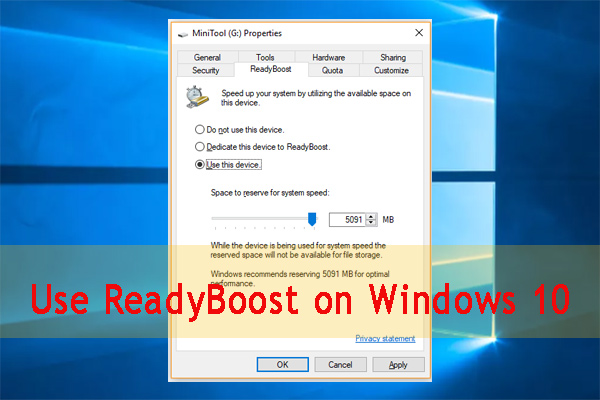

If the system drive (the primary drive, with Windows system files on it) is a solid-state drive (SSD), ReadyBoost is disabled, since reading from that drive would be at least as fast as reading from the ReadyBoost drive.The ReadyBoost cache is created on the root directory of the drive. Because ReadyBoost stores its cache as a file on the root directory of the drive rather than using the flash memory without a file system, the file system must be mounted and assigned a drive letter.One experiment showed reading of flash memory up to 5–10 times faster than Windows Vista due to higher hit rate. The ReadyBoost algorithm was improved in Windows 7, resulting in better performance.
#What is readyboost windows 7
Windows 7 supports multiple flash drives for ReadyBoost, so performance improvement similar to RAID 0 can be expected. The initial release of ReadyBoost for Windows Vista supported one device.The performance differences between these file systems are negligible with ReadyBoost. As the ReadyBoost cache is stored as a file, the flash drive must be formatted as FAT32, NTFS, or exFAT in order to have a cache size greater than FAT16's 2 GB filesize limit if the desired cache size is 4 GB (the FAT32 filesize limit) or larger, the drive must be formatted as NTFS or exFAT. Windows 7 also supports the newer exFAT file system. Vista's ReadyBoost supports NTFS, FAT16, and FAT32 from SP1 onwards.The Microsoft Windows Client Performance group recommends a flash-memory-to-system-RAM ratio of between 1:1 and 2.5:1.The device must be capable of 2.5 Mbit/s read speeds for 4 kB random reads spread uniformly across the entire device, and 1.75 Mbit/s write speeds for 512 kB random writes spread uniformly across the device.The device must have an access time of 1 ms or less.Windows 7 allows up to eight devices for a maximum of 256 GB of additional memory, with up to 32 GB on a single storage device.The removable media's capacity must be at least 256 MB (250 MB after formatting, Windows 7 reports in its Event Log a required minimum of 235 MB).Requirements įor a device to be compatible and useful, it must conform to these requirements: ReadyBoost compresses and encrypts all data that is placed on the flash device with AES-128 Microsoft has stated that a 2:1 compression ratio is typical, so a 4 GB cache would usually contain 8 GB of data. Windows Vista allows only one device to be used, while Windows 7 allows multiple caches, one per device, up to a total of 256 GB.

In Windows 7 or later with NTFS or exFAT formatting, the maximum cache size is 32 GB per device. In Vista or with FAT32 formatting of the drive, the maximum is 4 GB. When a compatible device is plugged in, the Windows AutoPlay dialog offers an additional option to use the flash drive to speed up the system an additional ReadyBoost tab is added to the drive's properties dialog where the amount of space to be used can be configured.

Flash devices typically are slower than a mechanical hard disk for sequential I/O, so, to maximize performance, ReadyBoost includes logic that recognizes large, sequential read requests and has the hard disk service these requests.

This caching applies to all disk content, not just the page file or system DLLs. Using ReadyBoost-capable flash memory ( NAND memory devices) for caching allows Windows Vista and later to service random disk reads with better performance than without the cache.


 0 kommentar(er)
0 kommentar(er)
